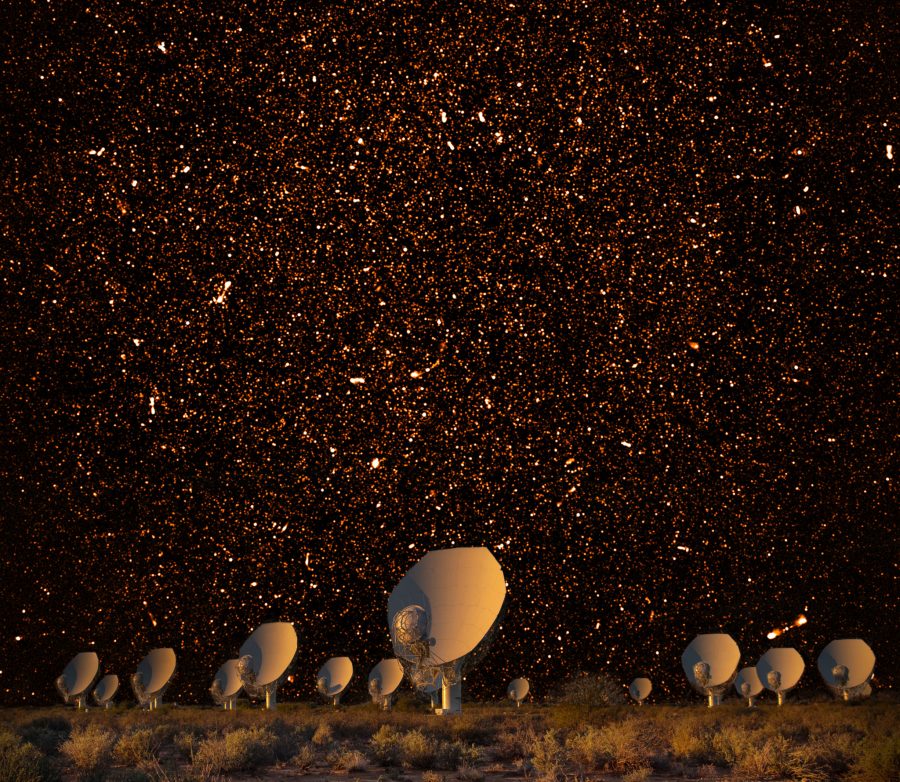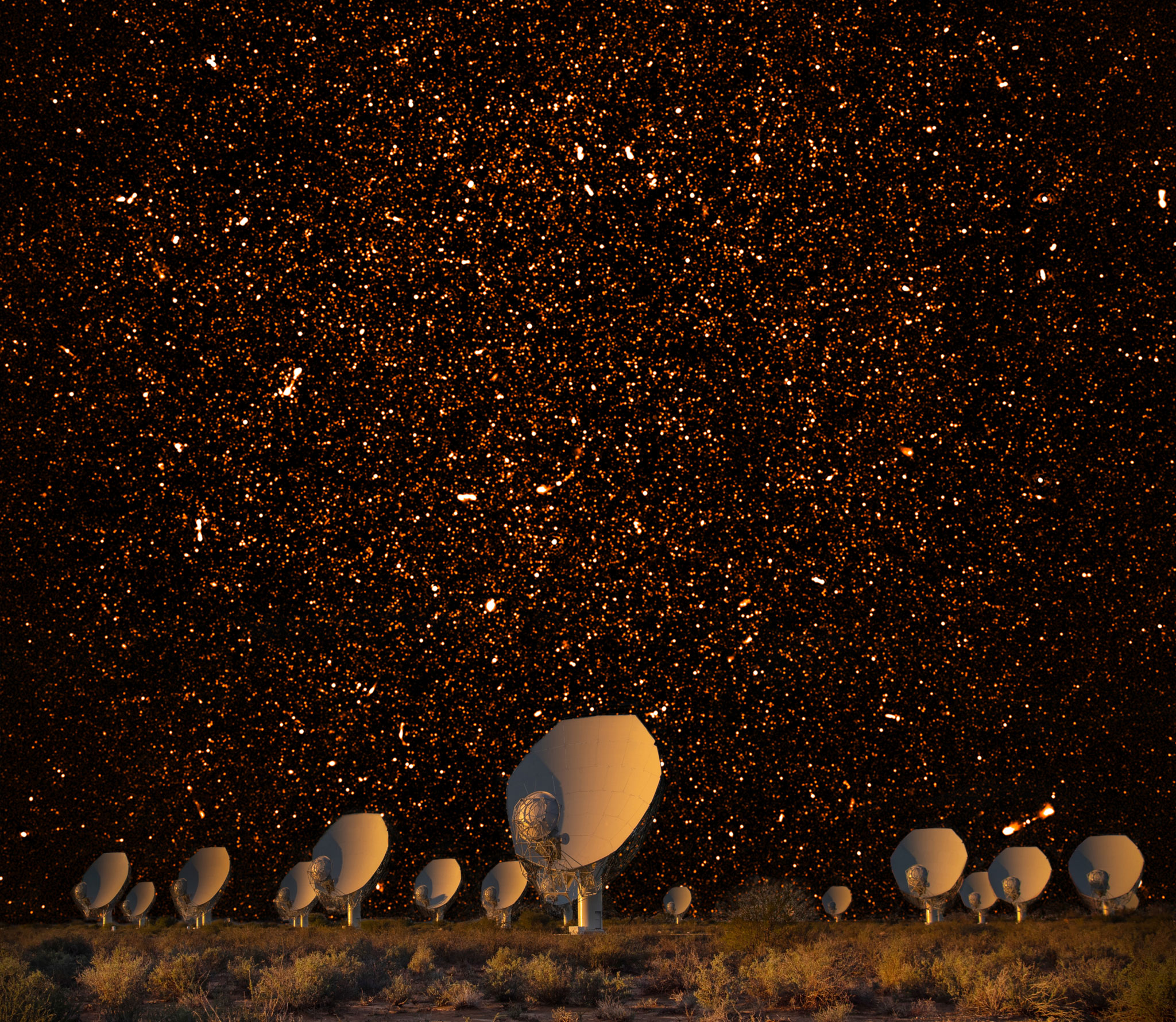
South Africa’s MeerKAT Telescope Captures Never Before Seen Galaxies Like Our Own
Look at this new radio image – from South Africa’s Meerkat telescope – covered with dots, each of which is a distant galaxy! The brightest spots are galaxies that are powered by supermassive black holes and shine bright in radio light. But what makes this image special are the numerous faint dots filling the sky. […]

Look at this new radio image – from South Africa’s Meerkat telescope – covered with dots, each of which is a distant galaxy! The brightest spots are galaxies that are powered by supermassive black holes and shine bright in radio light. But what makes this image special are the numerous faint dots filling the sky. These are distant galaxies like our own that have never been observed in radio light before.
To learn about the star-formation history of the universe, we need to look back in time. Galaxies throughout the universe have been forming stars for the past 13 billion years. But most stars were born between 8 and 11 billion years ago, during an era called “cosmic noon”.
It has been a challenge for astronomers to study the faint light coming from this era. Optical telescopes, like SALT in Sutherland, can see very distant galaxies, but new stars are largely hidden inside dusty clouds of gas. Radio telescopes can see through the dust and observe the rare, bright “starburst” galaxies, but until now have not been sensitive enough to detect the signals from distant Milky Way-like galaxies that are responsible for most of the star formation in the universe.

An international team of astronomers, using the South African Radio Astronomy Observatory (SARAO) MeerKAT telescope near Carnarvon in the Northern Cape, recently made the first radio observation sensitive enough to reveal these galaxies. “To make this image, we selected an area in the Southern Sky that contains no strong radio sources whose glare could blind a sensitive observation,” said Tom Mauch of SARAO in Cape Town, who led the team who has had their results accepted for publication in The Astrophysical Journal.
The team used the 64 MeerKAT dishes to observe this area for a total of 130 hours. The resulting image shows a region of the sky that is comparable in area to five full Moons, containing tens of thousands of galaxies.
“Because radio waves travel at the speed of light, this image is a time machine that samples star formation in these distant galaxies over billions of years,” explained co-author James Condon of the National Radio Astronomy Observatory in the USA. “Because only short-lived stars that are less than 30 million years old send out radio waves, we know that the image is not contaminated by old stars. The radio light we see from each galaxy is therefore proportional to its star-forming rate at that moment in time.”

The astronomers want to use this image to learn more about star formation in the entire universe. “These first results indicate that the star-formation rate around cosmic noon is even higher than was originally expected,” said Allison Matthews, a PhD student at the University of Virginia. “Previous images could only detect the tip of the iceberg, the rare and luminous galaxies that produced only a small fraction of the stars in the universe. What we see now is the complete picture: these faint dots are the galaxies that formed most of the stars in the universe.”
“MeerKAT is the best radio array in the world for studies like this one because it is the first to use such a large number of extremely low-noise clear-aperture dishes,” explained SARAO Chief Technologist Justin Jonas. As a result, the MeerKAT image (nicknamed “DEEP2”) is more sensitive to distant star-forming galaxies than any previous view of the radio sky.
***
PAPER
This research is presented in an article titled “The 1.28 GHz MeerKAT DEEP2 Image,” by T. Mauch et al., accepted for publication in The Astrophysical Journal.
MeerKAT, originally the Karoo Array Telescope, is a radio telescope inaugurated in 2018 consisting of 64 antennas spread over a diameter of eight kilometers in the Northern Cape province of South Africa. It is the most sensitive telescope of its kind in the world and is a precursor to the Square Kilometre Array (SKA) radio telescope, to be built in South Africa and Australia within the coming decade.
The MeerKAT telescope is operated by the South African Radio Astronomy Observatory, which is a facility of the National Research Foundation, an agency of the Department of Science and Innovation.
THE SOUTH AFRICAN RADIO ASTRONOMY OBSERVATORY
The South African Radio Astronomy Observatory (SARAO), a facility of the National Research Foundation, is responsible for managing all radio astronomy initiatives and facilities in South Africa, including the MeerKAT radio telescope in the Karoo, and the geodesy and VLBI activities at the HartRAO facility. SARAO also coordinates the African Very Long Baseline Interferometry Network (AVN) for the eight SKA partner countries in Africa, as well as South Africa’s contribution to the infrastructure and engineering planning for the Square Kilometre Array radio telescope. To maximise the return on South Africa’s investment in radio astronomy, SARAO is managing programmes to create capacity in radio astronomy science and engineering research, and the technical capacity required to support site operations.
